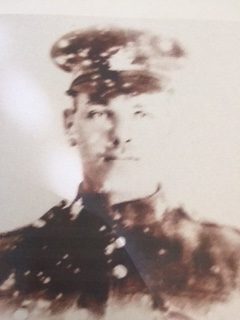Personal Details
Born: 16 August 1889 in Bettisfield, Flintshire and baptised on 1 September 1889 at Hanmer Parish Church, Hanmer, Flintshire.
Family: He was the eldest of three children born to John McHugh, a publican and his wife Anne Elizabeth, nee Edwards. He appears to have married in Canada, though no actual records can be found for a marriage. The couple had a daughter, Bertha E, born in 1928. On the 1939 Register he is described as a widower. He married Ethel E West in 1940 in Gipping, Suffolk. No children can be found for this marriage.
Residence: In 1891 his family were living 34 Coleridge Street, West Derby, Lancashire. Ten years later his mother was a widow and the family were living at Tarts Hill, Bettisfield, Flintshire. In 1911 he was living at 25 Cross Street, Ellesmere, Shropshire. In 1914 he emigrated to Canada and appears to have settled in the province of Saskatchewan. He returned to England in 1935 and in 1939 his address was Rectory Farm, Church Hill, Southwell, Nottinghamshire. At the time of his death in 1970 his home was 13 Bride Street, Needham Market, Suffolk.
Employment: In 1911 he was a baker. Whilst in Canada his occupation was a farmer. In 1939 he was an agricultural worker.
Died: 14 October 1970 in the Samford district of Suffolk, aged 80.
Military Details
Regiment: Canadian Expeditionary Force
Rank: Lance Corporal
Service Number: 84153
Date of Enlistment: 27 November 1915
Date of Discharge: 8 February 1919
Reason for Discharge: Demobilisation
Other Information: Whilst serving in France he was wounded on two separate occasions. The first time he received a gunshot wound to his shoulder and on the second occasion shrapnel wounds to his face and knee.
Robert was awarded the Campaign medals (Victory and British War Medals)

The British War Medal (also known as 'Squeak') was a silver or bronze medal awarded to officers and men of the British and Imperial Forces who either entered a theatre of war or entered service overseas between 5th August 1914 and 11th November 1918 inclusive. This was later extended to services in Russia, Siberia and some other areas in 1919 and 1920. Approximately 6.5 million British War Medals were issued. Approximately 6.4 million of these were the silver versions of this medal. Around 110,000 of a bronze version were issued mainly to Chinese, Maltese and Indian Labour Corps. The front (obv or obverse) of the medal depicts the head of George V. The recipient's service number, rank, name and unit was impressed on the rim.
The Allied Victory Medal (also known as 'Wilfred') was issued by each of the allies. It was decided that each of the allies should each issue their own bronze victory medal with a similar design, similar equivalent wording and identical ribbon. The British medal was designed by W. McMillan. The front depicts a winged classical figure representing victory. Approximately 5.7 million victory medals were issued. Interestingly, eligibility for this medal was more restrictive and not everyone who received the British War Medal ('Squeak') also received the Victory Medal ('Wilfred'). However, in general, all recipients of 'Wilfred' also received 'Squeak' and all recipients of The 1914 Star or The 1914/1915 Star (also known as 'Pip') also received both 'Squeak' and 'Wilfred'. The recipient's service number, rank, name and unit was impressed on the rim.

